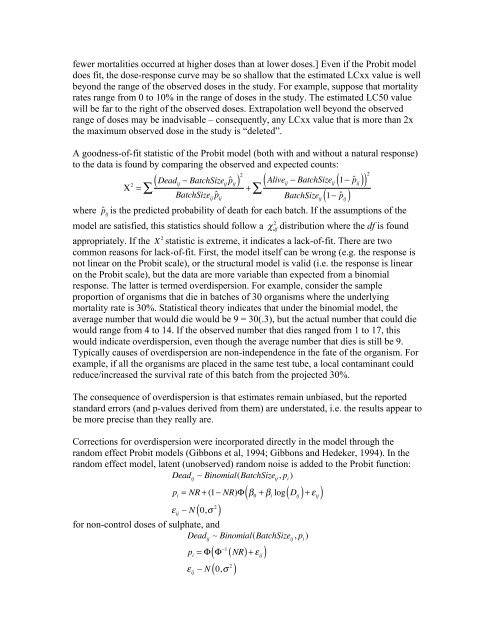Summary - People.stat.sfu.ca - Simon Fraser University
Summary - People.stat.sfu.ca - Simon Fraser University
Summary - People.stat.sfu.ca - Simon Fraser University
Create successful ePaper yourself
Turn your PDF publications into a flip-book with our unique Google optimized e-Paper software.
fewer mortalities occurred at higher doses than at lower doses.] Even if the Probit modeldoes fit, the dose-response curve may be so shallow that the estimated LCxx value is wellbeyond the range of the observed doses in the study. For example, suppose that mortalityrates range from 0 to 10% in the range of doses in the study. The estimated LC50 valuewill be far to the right of the observed doses. Extrapolation well beyond the observedrange of doses may be inadvisable – consequently, any LCxx value that is more than 2xthe maximum observed dose in the study is “deleted”.A goodness-of-fit <strong>stat</strong>istic of the Probit model (both with and without a natural response)to the data is found by comparing the observed and expected counts:( Dead! 2 ij" BatchSize ij ˆp ij ) 2( Alive ij" BatchSize ij ( 1" ˆp ij )) 2= # + #BatchSize ij ˆp ijBatchSize ij ( 1" ˆp ij )where ˆp ijis the predicted probability of death for each batch. If the assumptions of themodel are satisfied, this <strong>stat</strong>istics should follow a ! 2dfdistribution where the df is foundappropriately. If the X 2 <strong>stat</strong>istic is extreme, it indi<strong>ca</strong>tes a lack-of-fit. There are twocommon reasons for lack-of-fit. First, the model itself <strong>ca</strong>n be wrong (e.g. the response isnot linear on the Probit s<strong>ca</strong>le), or the structural model is valid (i.e. the response is linearon the Probit s<strong>ca</strong>le), but the data are more variable than expected from a binomialresponse. The latter is termed overdispersion. For example, consider the sampleproportion of organisms that die in batches of 30 organisms where the underlyingmortality rate is 30%. Statisti<strong>ca</strong>l theory indi<strong>ca</strong>tes that under the binomial model, theaverage number that would die would be 9 = 30(.3), but the actual number that could diewould range from 4 to 14. If the observed number that dies ranged from 1 to 17, thiswould indi<strong>ca</strong>te overdispersion, even though the average number that dies is still be 9.Typi<strong>ca</strong>lly <strong>ca</strong>uses of overdispersion are non-independence in the fate of the organism. Forexample, if all the organisms are placed in the same test tube, a lo<strong>ca</strong>l contaminant couldreduce/increased the survival rate of this batch from the projected 30%.The consequence of overdispersion is that estimates remain unbiased, but the reportedstandard errors (and p-values derived from them) are under<strong>stat</strong>ed, i.e. the results appear tobe more precise than they really are.Corrections for overdispersion were incorporated directly in the model through therandom effect Probit models (Gibbons et al, 1994; Gibbons and Hedeker, 1994). In therandom effect model, latent (unobserved) random noise is added to the Probit function:Dead ij! Binomial(BatchSize ij, p i)( ( ) + $ ij )p i= NR + (1! NR)" # 0+ # ilog D ij( )$ ij! N 0,% 2for non-control doses of sulphate, andDead ij! Binomial(BatchSize ij, p i)( )( )p i= ! ! "1( NR) + # ij# ij! N 0,$ 2
















